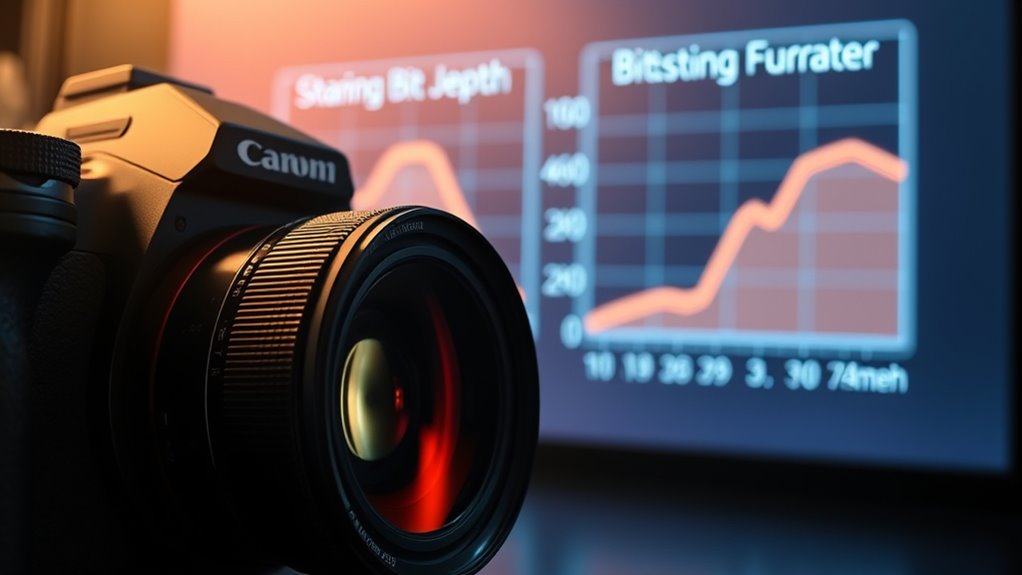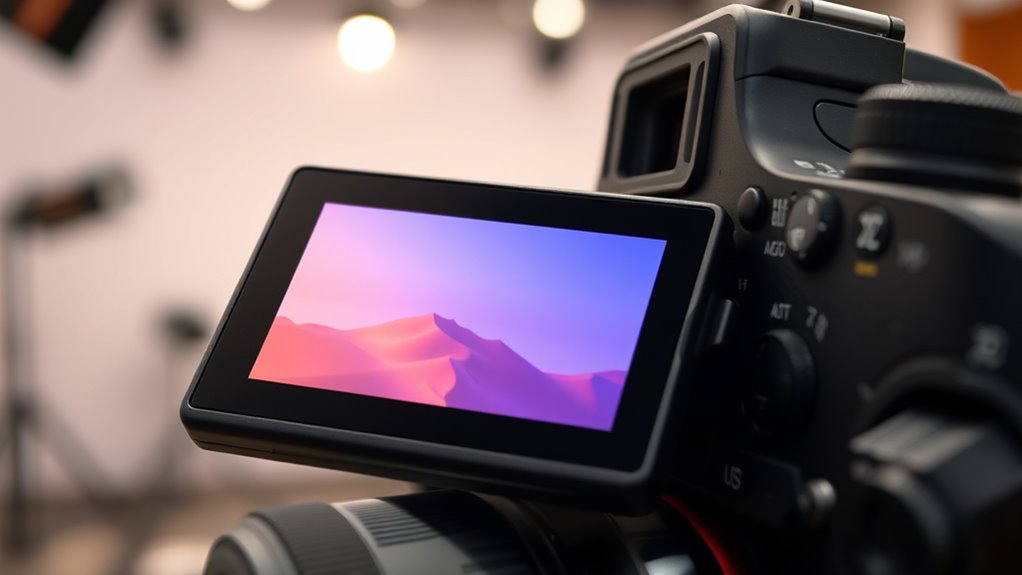Bit depth and bitrate are essential but often misunderstood factors in image and video quality. Bit depth controls the number of color shades and gradations captured, affecting color accuracy and dynamic range. Bitrate determines how much data flows per second, impacting clarity, file size, and streaming smoothness. While higher bit depth improves color fidelity, increasing bitrate enhances overall detail. Understanding their differences helps you optimize your footage, and there’s more to discover for better results.
Key Takeaways
- Bit depth affects color accuracy and gradation, while bitrate influences overall image clarity and file size.
- Higher bit depth reduces banding and posterization, especially during color grading and post-processing.
- Increasing bitrate enhances detail and sharpness but doesn’t improve color fidelity like higher bit depth.
- Both parameters impact media quality: bit depth for color richness, bitrate for resolution and compression artifacts.
- Balancing bit depth and bitrate is essential for optimal video quality, file size, and hardware compatibility.
Understanding Bit Depth: The Foundation of Image and Video Quality

Understanding bit depth is essential because it directly influences the quality of images and videos. When capturing footage, a higher bit depth allows more color information, which is vital during color grading. This means you can adjust colors more precisely without losing detail or introducing banding. Additionally, bit depth impacts sensor resolution’s effectiveness—higher bit depths make the most of your camera’s sensor capabilities by accurately representing subtle tonal variations. This results in richer, more realistic images. Lower bit depths reduce color accuracy and can cause posterization, especially during post-processing. So, when choosing your camera or editing footage, remember that bit depth forms the foundation for detailed, vibrant visuals, enabling professional-grade color grading and maximizing your sensor’s potential. Higher bit depths also provide better flexibility in post-production, allowing for more extensive editing without degrading image quality.
What Is Bitrate and How Does It Affect Media Files?

Have you ever noticed how some videos look crisp and clear while others appear blurry or blocky? That’s often due to bitrate, which controls how much data is transmitted per second. Higher bitrates allow for more information to be sent, resulting in better image quality, especially in complex scenes. Conversely, lower bitrates use aggressive compression techniques, reducing file size but sacrificing detail and clarity. Bitrate directly impacts data transmission, affecting how smoothly your media plays—especially during fast motion or detailed shots. If the bitrate is too low, you’ll see artifacts, pixelation, or lag. Finding the right balance guarantees your videos retain quality without overwhelming your storage or bandwidth. In short, bitrate is key to delivering high-quality media that looks good and performs well. Understanding video compression methods can help optimize your media quality without sacrificing performance.
Comparing Bit Depth and Bitrate: Key Differences Explained

While both bit depth and bitrate influence media quality, they serve distinct purposes and operate differently. Bit depth determines the number of color shades in each pixel, affecting how smoothly colors progress during color grading and how well details are preserved. Higher bit depth reduces compression artifacts and provides more flexibility in post-production. Bitrate, on the other hand, controls how much data is allocated per second of video or audio. Increasing bitrate improves overall quality, but it doesn’t expand color information like bit depth does. Instead, it reduces compression artifacts and enhances clarity. In short, bit depth enhances color accuracy and dynamic range, while bitrate primarily impacts overall quality and file size. Both are essential but affect media differently, making understanding their differences essential for best results. Additionally, understanding color fidelity can help optimize media output for various display devices.
How Bit Depth Impacts Color Accuracy and Dynamic Range

Bit depth directly influences how accurately colors are represented and how much detail your video can display in bright and dark areas. Higher bit depth increases color fidelity by allowing more subtle gradations between shades, reducing banding and posterization. This means your footage will look more natural and true to life. Additionally, greater bit depth expands the dynamic range, giving you a broader spectrum between the brightest highlights and darkest shadows. This enables you to capture more detail in high-contrast scenes without sacrificing image quality. When you choose higher bit depth, you’re ensuring your videos have richer, more accurate colors and better detail retention across varied lighting conditions. In short, bit depth plays a vital role in elevating both color accuracy and dynamic range in your footage. Utilizing wall organization systems with proper lighting can further enhance the visual quality of your videos by reducing clutter and creating an aesthetically pleasing environment.
The Role of Bitrate in Streaming, Recording, and File Size

Bitrate plays a vital role in determining video quality, storage needs, and bandwidth requirements. Higher bitrates usually mean better quality but larger files and more data transfer, which can challenge your system or internet connection. Finding the right balance is key to achieving ideal streaming performance without sacrificing too much file size or quality. Additionally, understanding the natural techniques for optimizing content can help in maintaining high quality without excessively increasing bitrate demands.
Impact on Video Quality
The quality of your video heavily depends on the bitrate, which determines how much data is processed per second. A higher bitrate generally means sharper images, better color grading, and less compression artifacts. However, it also impacts hardware compatibility, as demanding bitrates require more powerful devices for smooth playback. Consider these factors:
- Increased detail preservation during recording and streaming.
- Reduced compression artifacts, especially in fast motion scenes.
- Enhanced color accuracy, essential for professional color grading.
- Greater demands on hardware, influencing compatibility and performance.
Balancing bitrate ensures ideal video quality without overloading your system. Choosing the right bitrate helps maintain clarity and detail while ensuring your hardware can handle the workload, especially during editing or playback.
Storage and Bandwidth Needs
When you stream, record, or store videos, understanding how bitrate affects file size and bandwidth is vital. Higher bitrates improve image quality but also increase file sizes, requiring more storage space and greater bandwidth for smooth playback. Compression efficiency plays a key role here; more efficient codecs reduce file size without sacrificing quality, helping with storage optimization. If your bitrate is too high, you’ll need more storage capacity and higher bandwidth, which can strain your system or streaming platform. Conversely, too low a bitrate may cause quality loss, leading to buffering or pixelation. Balancing bitrate ensures you optimize storage and bandwidth use, maintaining acceptable quality while avoiding unnecessary resource consumption. Additionally, the choice of churning methods can influence the consistency and texture of the final product, highlighting the importance of proper process management. This understanding helps you manage your media infrastructure effectively.
Optimal Settings for Streaming
Choosing the right bitrate is essential for achieving ideal streaming quality without overloading your bandwidth or storage. A proper bitrate guarantees smooth playback and preserves details during color grading. To optimize your settings, consider these factors:
- Select a bitrate that balances quality and bandwidth, typically between 3,000 to 6,000 kbps for HD streams.
- Use efficient compression algorithms like H.264 or H.265 to reduce file size without sacrificing quality.
- Adjust the bitrate based on content complexity—high-motion scenes need higher bitrates.
- Keep in mind that lower bitrates can lead to artifacts affecting color grading, so find a balance that preserves detail.
Practical Tips for Adjusting Bit Depth and Bitrate for Better Results

Adjusting bit depth and bitrate effectively can substantially improve your audio quality without unnecessarily increasing file size. For better results, start by understanding how higher bit depth preserves more color information, which is vital during color grading. When editing, choose a higher bit depth to prevent banding and retain detail. For bitrate, balance is key: increasing it improves audio clarity but also enlarges files. Use compression techniques to optimize this balance, reducing file size without sacrificing quality. When recording video, set a higher bitrate during complex scenes to maintain detail. Experiment with different settings to find the best mix for your workflow. Always review your footage and listen carefully to guarantee adjustments enhance quality without adding unwanted artifacts or noise. Additionally, understanding the legal finality of a process can help you plan your edits and exports accordingly.
Common Myths About Bit Depth and Bitrate Debunked

Many common misconceptions about bit depth and bitrate can lead you to make suboptimal choices, potentially compromising your video quality during color grading or introducing compression artifacts. Here are some myths debunked:
- Higher bit depth always equals better quality—unless your display or workflow can’t utilize it.
- Increasing bitrate guarantees lossless quality—compression artifacts can still occur if settings are poorly optimized.
- Bitrate doesn’t impact color grading flexibility—higher bitrates preserve more color information, aiding adjustments.
- More bits per pixel always mean smoother gradients—proper encoding and color depth are *fundamental* for avoiding banding.
Understanding these myths helps you choose appropriate settings, balancing file size, quality, and editing needs while minimizing compression artifacts.
Frequently Asked Questions
How Do Bit Depth and Bitrate Influence Editing Flexibility?
You’ll find that higher bit depth and bitrate give you more editing flexibility by providing richer color grading options and reducing compression artifacts. Increased bit depth captures more color information, making adjustments smoother, while higher bitrate preserves detail during compression. This means you can tweak contrast, shadows, and highlights without sacrificing quality, giving you cleaner, more professional results during editing.
Can Increasing Bit Depth or Bitrate Improve Low-Light Performance?
Increasing bit depth or bitrate doesn’t directly boost low-light performance, but it helps you capture more detail and reduce noise during editing. With higher sensor sensitivity, your camera gathers more light, and better bit depth allows for improved noise reduction. This combination results in cleaner, clearer images in low light. So, while they don’t improve sensitivity directly, they give you more flexibility to enhance low-light shots in post-production.
Are Higher Bit Depths Always Better for Professional Workflows?
Higher bit depths aren’t always better for professional workflows, but they do offer increased color grading flexibility and expanded dynamic range. If you work on complex projects with rich color palettes or need detailed adjustments, higher bit depths help preserve image quality. However, they also require more storage and processing power. Consider your project’s needs; if you prioritize detailed color grading and broad dynamic range, higher bit depths can be a valuable choice.
How Do Bit Depth and Bitrate Affect File Compatibility Across Devices?
Higher bit depths and bitrate improve color accuracy, but they can also augment file size, which may affect compatibility across devices. You’ll need to balance quality with file size to guarantee your files open smoothly on various systems. If a device struggles with large files, consider lowering bitrate or bit depth slightly. This helps maintain compatibility without sacrificing too much color detail or overall quality.
What Is the Ideal Balance Between Bit Depth and Bitrate for Streaming?
For streaming, aim for a balance where about 4-6 Mbps provides smooth playback for HD videos, covering roughly 90% of viewers’ internet speeds. You want enough bitrate for compression efficiency and color accuracy without causing buffering. Too high, and you risk lag; too low, and quality suffers. Adjust your bit depth and bitrate to optimize clarity and performance, ensuring your audience gets a crisp, seamless experience.
Conclusion
Understanding the difference between bit depth and bitrate is crucial for getting the best quality out of your media. While they both influence your images and videos, they serve different purposes—one controls color and dynamic range, the other file size and streaming quality. Don’t put all your eggs in one basket; balancing both settings lets you strike the perfect harmony between quality and efficiency. Master these, and you’ll truly access your camera’s full potential.










